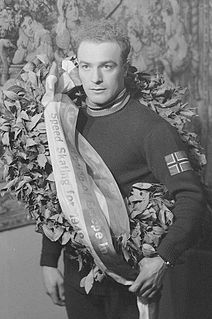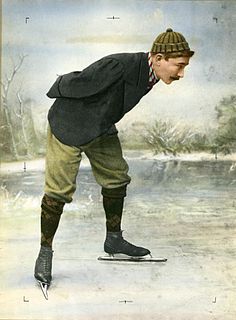
Speed skating is a competitive form of ice skating in which the competitors race each other in travelling a certain distance on skates. Types of speed skating are long track speed skating, short track speed skating, and marathon speed skating. In the Olympic Games, long-track speed skating is usually referred to as just "speed skating", while short-track speed skating is known as "short track". The International Skating Union (ISU), the governing body of competitive ice sports, refers to long track as "speed skating" and short track as "short track skating".

Short track speed skating is a form of competitive ice speed skating. In competitions, multiple skaters skate on an oval ice track with a length of 111.111 metres (364.54 ft). The rink itself is 60 metres (196.85 ft) long by 30 metres (98.43 ft) wide, which is the same size as an Olympic-sized figure skating rink and an international-sized ice hockey rink. Related sports include long track speed skating and inline speed skating.
The World Allround Speed Skating Championships are a series of speed skating events held annually to determine the best allround speed skater of the world. The event is held over two days, with all skaters entering the first three distances and the best eight skaters over these distances getting to ride the last event. The results of the races are converted to points, and the skater with lowest total score wins the championship.

Shani Earl Davis is an American former speed skater.

Vikingskipet, officially known as Hamar Olympic Hall, is an indoor multi-use sport and event venue in Hamar, Norway. It was built as the speed skating rink for the 1994 Winter Olympics, and has since also hosted events and tournaments in ice speedway, rally, association football, bandy, ice sledge speed racing, flying disc and track cycling. The arena is also used for concerts, trade fair and the annual computer party The Gathering. It is the home arena of Hamar IL bandy team. The venue is owned by Hamar Municipality, and along with Hamar Olympic Amphitheatre is run by the municipal Hamar Olympiske Anlegg. Vikingskipet has a capacity for 10,600 spectators during sporting events and 20,000 during concerts.

Sverre Farstad was a Norwegian speed skater representing Sportsklubben Falken, Trondheim, as part of the Falken Trio also including Henry Wahl and Hjalmar Andersen. Farstad won one Olympic gold medal and one European Championship in his three-year international career.

Christine Nesbitt is a Canadian retired long track speed skater who currently resides in Vancouver, British Columbia. She won the gold medal in the 1000 metres event at the Vancouver 2010 Winter Olympics. She had previously won a silver medal in the team pursuit at the 2006 Winter Olympics in Turin. She is also the 2011 sprint champion, 2012 1500 metres world champion, three-time world champion for 1000 metres, and three-time world champion for team pursuit. On 4 June 2015 she announced her retirement.

Nagano Olympic Memorial Arena, or M-Wave, is a covered speed skating oval in the city of Nagano, Japan. M-Wave, which opened in November, 1996, was constructed for the speed skating events at the 1998 Winter Olympics. It was Japan's first International Skating Union (ISU) standard indoor 400m double-track, and only second indoor track speed skating in Japan. The other, Meiji Hokkaido-Tokachi Oval, is located in Obihiro, Hokkaido.

The 2009 World Allround Speed Skating Championships were held at the indoor ice rink of the Vikingskipet Olympic Arena in Hamar (Norway) on 7 and 8 February 2009.

The 2010 World Allround Speed Skating Championships were held at the indoor ice rink of the Thialf in Heerenveen, Netherlands on 19, 20 and 21 March 2010.

The 2011 World Allround Speed Skating Championships was held at the indoor ice rink of the Olympic Oval in Calgary, Alberta, (Canada) on 12 and 13 February 2011.
A speed skating rink is an ice rink in which a speed skating competition is held.

The Gangneung Oval is a speed skating oval in South Korea, which was used for the speed skating competitions at the 2018 Winter Olympics. The building of the oval was started in September 2013. The venue consists of a double track 400 metre rink and has a capacity of 8000 seats. It has three floors above ground and two underground levels. The original plan was to build the venue at the Gangneung Science Park, but because there was limited space due to the number of local businesses taking the opportunity to relocate, the oval was built in the Gangneung Olympic Park, in the vicinity of the Gangneung Ice Arena and Gangneung Hockey Centre.

Jacob Jorrit Bergsma is a Dutch speed skater and marathon skater. At the 2014 Winter Olympics, he won the gold medal in the 10,000 m. His coach is Jillert Anema.

The 2012 European Speed Skating Championships was the 37th continental speed skating event for women and the 106th for men, that was held at the City Park Ice Rink in Budapest, Hungary, from 6 to 8 January 2012. The competition was also a qualifying event for the 2012 World Allround Speed Skating Championships as the entry quotas were allocated according to the results of the European Championships.

The 1893 World Allround Speed Skating Championships took place at 13 and 14 January at the ice rink Museumplein in Amsterdam, the Netherlands. It is the fourth World Allround Speed Skating Championships organised at the Museumplein in Amsterdam.. It was the first official World Allround Speed Skating Championship after the foundation of the International Skating Union (ISU) in 1892. The Dutch skater Jaap Eden became the first official ISU-World allround by winning the 1500, 5000 en 500 meter. He did not need to finish the 10000m according to the rules. Oskar Fredriksen from Norway skated the championship the first World record at the 10000 meter.
The 2014–15 ISU Speed Skating World Cup, officially the Essent ISU World Cup Speed Skating 2014–2015, was a series of international speed skating competitions that ran the entire season. The season started on 14 November 2014 in Obihiro, Japan, and ended with the final on 22 March 2015 in Erfurt, Germany. In total, seven competition weekends were held at six different locations, twelve cups were contested, and 80 races took place.
The 2015–16 ISU Speed Skating World Cup, officially the ISU World Cup Speed Skating 2015–2016, was a series of international speed skating competitions that ran the entire season. The season started on 13 November 2015 in Calgary, Alberta, Canada, and ended with the final on 13 March 2016 in Heerenveen, Netherlands.
The 2016–17 ISU Speed Skating World Cup, officially the ISU World Cup Speed Skating 2016–2017, was a series of international speed skating competitions that ran the entire season. The season started on 11 November 2016 in Harbin, China, and ended with the final on 11 March 2017 in Stavanger, Norway.
























